After having woken up just in time for the sunrise on Mount Batur in Bali and then on Kawah Ijen and Bromo (almost in a row), we must admit that we arrived in Yogyakarta a little bit tired. Moreover, we had not had great hygiene conditions during these last 4 days. The combo of the 2 had won over Fabienne and she remained stuck in bed with an infection during our stay in Jogja. As we had a plane to Jakarta for Sydney 4 days later, it was impossible to extend our stay. So, I was deprived of my half for the last step in Indonesia! Anyway, I take you to the special territory of Yogyakarta and we tell you everything you need to know about Jogja and the biggest Buddhist temple in the world, Borobudur! Are you in?
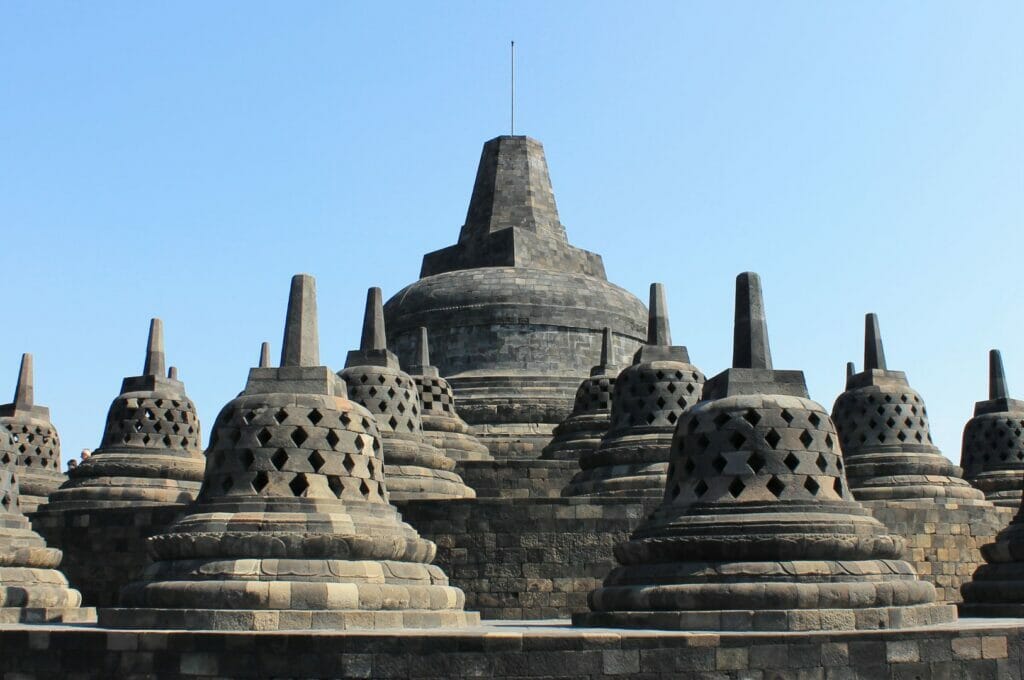
We took this trip in 2014, but the article was completely revised and updated in May 2023. If you see any price changes or have additional information that might be relevant, please feel free to leave us a comment!
Introduction to Yogyakarta in Indonesia
Yogyakarta is more commonly known as Jogja due to its ancient spelling. In addition to being the cultural capital of the island, Jogja is also the capital city of the eponymous territory which is located in Central Java. We must admit that almost everyone spends a day or two in Jogja to visit Borobudur and Prambanan, the most visited and famous temples in Indonesia!
However, Yogyakarta City has a lot to offer in many aspects! There are many handicraft stores and it is also the home of batik. You know, those colorful patterns on silk or cotton. Also, if you have not attended a traditional dance in Bali, Yogyakarta can be the opportunity to discover this traditional art. On the food side, you will see plenty of warungs in the streets offering delicious Indonesian dishes.
Environmentally, Yogyakarta is sandwiched between volcanoes and the ocean. It is a good starting point to explore the national parks containing the Merapi volcano and Mount Merbabu in the north, in Central Java, and the beaches along the Indian Ocean in the south. Whether you are a sea or mountain person, you will find what you are looking for in this region of Java!
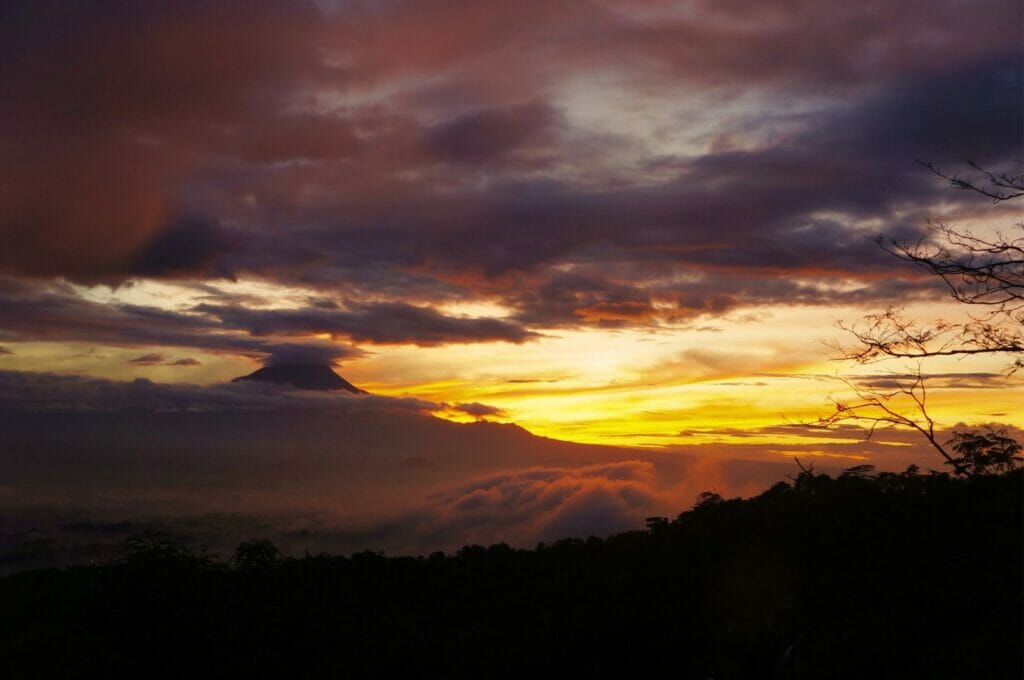
Arrival in Jogja and lack of hygiene on a round-the-world trip
When we are on a trip around the world as backpackers, it is usual to be confronted with rather a minimal comfort… This 4 days tour between Ijen and Bromo will have been a real immersion in local people. On the other hand, hygiene level, we’ll have to pass… In itself, nothing dramatic, we are not in sugar!
Spending 4 days without showering is not glamorous, especially when we trek, but during this trip, our couple has survived worse. On the other hand, we have to be careful because our little European bodies raised with antiseptics and impeccable hygiene conditions are not necessarily used to it. And a small wound of nothing at all can quickly turn into a nasty infection in these conditions! Guess who had to spend 3 weeks on antibiotics?
Don’t worry, nothing too serious for Fabienne! But this little mishap will have kept her in bed for a few days and made her discover the performances of the Indonesian medical system as well as the Australian hospitals… Yes, when the Indonesian doctor gives you antibiotics for bronchitis as well as antiallergic drugs, it doesn’t make any difference for a skin infection! At least my Indonesian prescription made the Australian doctors smile. Once the right medication in my pocket, all’s well that ends well!
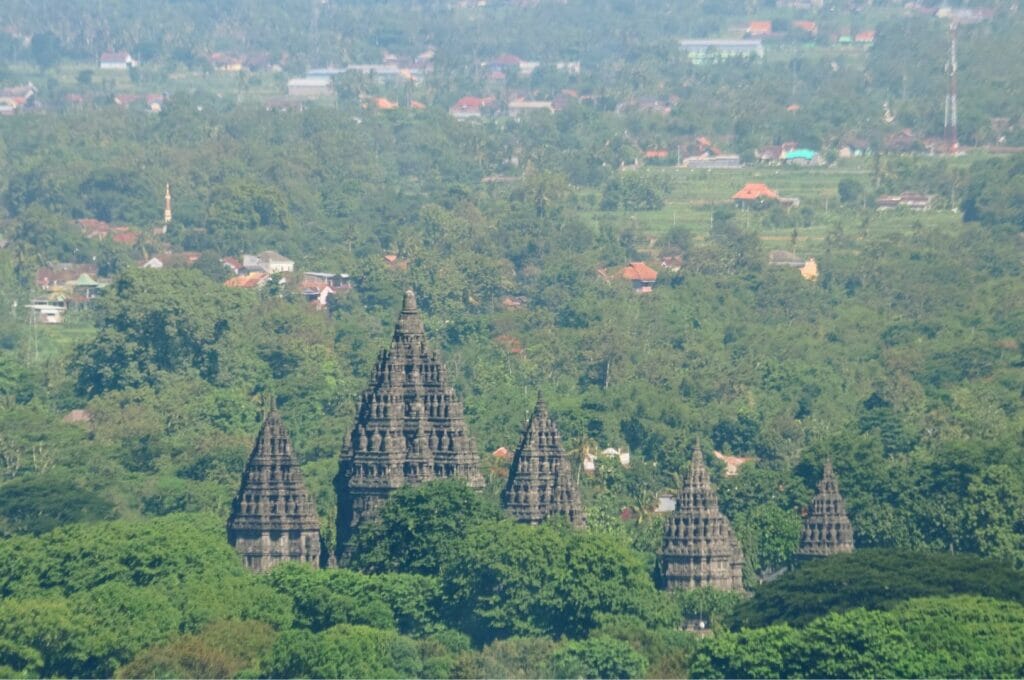
How to get to Yogyakarta?
Wherever you are in Indonesia, you will find a way to get to Yogyakarta City by train, bus, or plane.
From Kawah Ijen
To cross the island of Java between Banyuwangi (base of Kawah Ijen) and Yogyakarta, you have the choice between:
- train: for a single trip of about 11 hours, tickets cost between 240 000 and 550 000 rupiahs;
- bus: for a night journey of about 10 hours, tickets cost between 340 000 and 550 000 rupiahs;
- plane: be careful, few flights per month make the trip between the airport and the city.
From Mount Bromo
You can take the train or bus to go from Mount Bromo (Probolinggo) to Yogyakarta.
Directly
The train from Probolinggo serves 2 stations in Yogyakarta: Tugu (YK, the main station of Jogja) and Lempuyangan (LPN). Each train takes the same time (8 h) to within 10-15 min. Until Tugu, you have 2 trains, one at 7 a.m. and the other between 3 p.m. and 4 p.m. depending on the day and the price varies between 200 000 and 440 000 rupiahs. Until Lempuyangan, one train leaves at 8 a.m. and the other at 11:20 a.m., but the train tickets cost less, between 95 000 and 275 000 rupiahs. So it’s up to you to decide on your travel itinerary!
By bus, it would be possible to go directly from Probolinggo to the Giwangan terminal but we didn’t find much information about it. If you know more, don’t hesitate to leave us a comment! But considering the length of the journey, we recommend you take the train instead or cut in Surabaya or Malang.
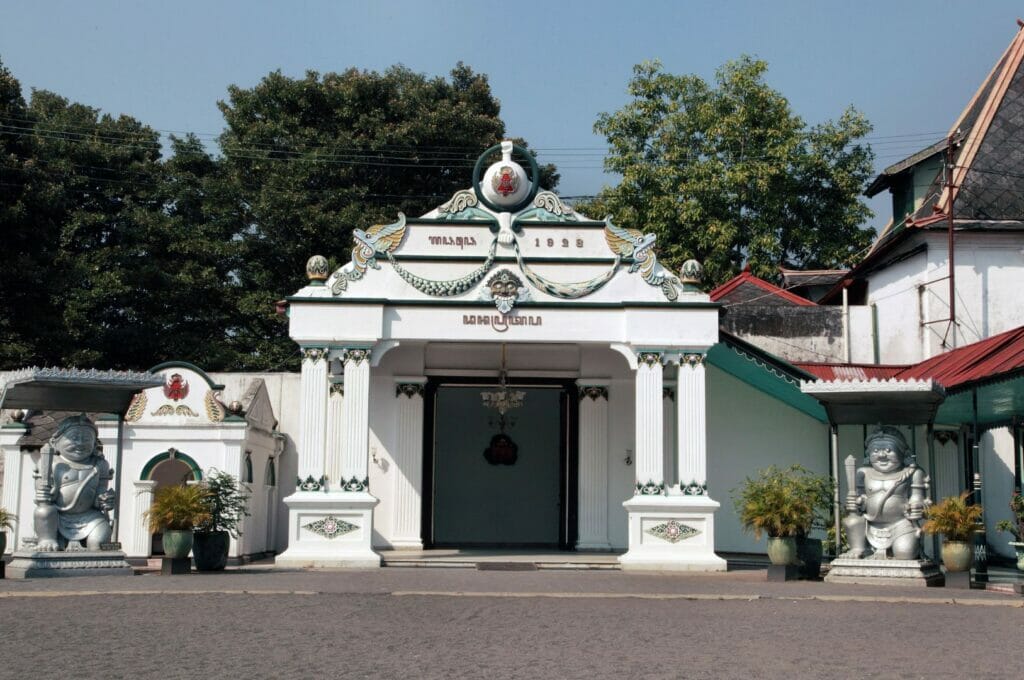
Passing through Surabaya
From Probolinggo, one of the solutions is to cut your trip in 2 by first going to Surabaya, then Yogyakarta:
- by train: the trip is done by one of the many trains that make the trip in 2 hours. Per person, the ticket costs between 27 000 and 330 000 rupiahs.
- by bus: there are several buses between Probolinggo and Surabaya. Tickets cost 120 000 rupiahs or 360 000 rupiahs depending on the type of bus you want.
Then, from Surabaya, you can reach Yogyakarta by train (around 200 000 rupiahs and between 4 hours and 6 hours of travel depending on the train and the arrival station Tugu (YK) or Lempuyangan (LPN)) or by bus (6 hours of travel for a ticket costing between 145 000 and 400 000 rupiahs).
Passing through Malang
If you prefer to go through a small town rather than Surabaya, Malang is an alternative. To reach Malang from Probolinggo:
- by train: there is only one train that runs daily from Probolinggo. It leaves at 10:00 a.m. for about 2 hours 45 minutes and the ticket price is 58 000 rupiahs.
- by bus: express buses leave in theory all day long for a 2.5-hour trip starting at 185 000 rupiahs.
Once in Malang, take an express bus for a 7.5-hour drive to Jogja with a fare between 180 000 and 450 000 rupiahs. By train, the travel time is a little shorter (about 6 hours and 15 minutes) and the price is between 144 000 and 560 000 rupiahs.
From Jakarta
Jogja is well connected to the Indonesian capital, Jakarta. Many trains leave the stations of Gambir and Pasar Senen every day to the east. The journey takes between 6 and 8 hours depending on the train for prices ranging from 240 000 to 1,3 million rupiahs depending on the class! Buses leave during the day and night to Yogyakarta, but the trip is longer (about 10-15 hours) for tickets ranging from 185 000 to 350 000 rupiahs.
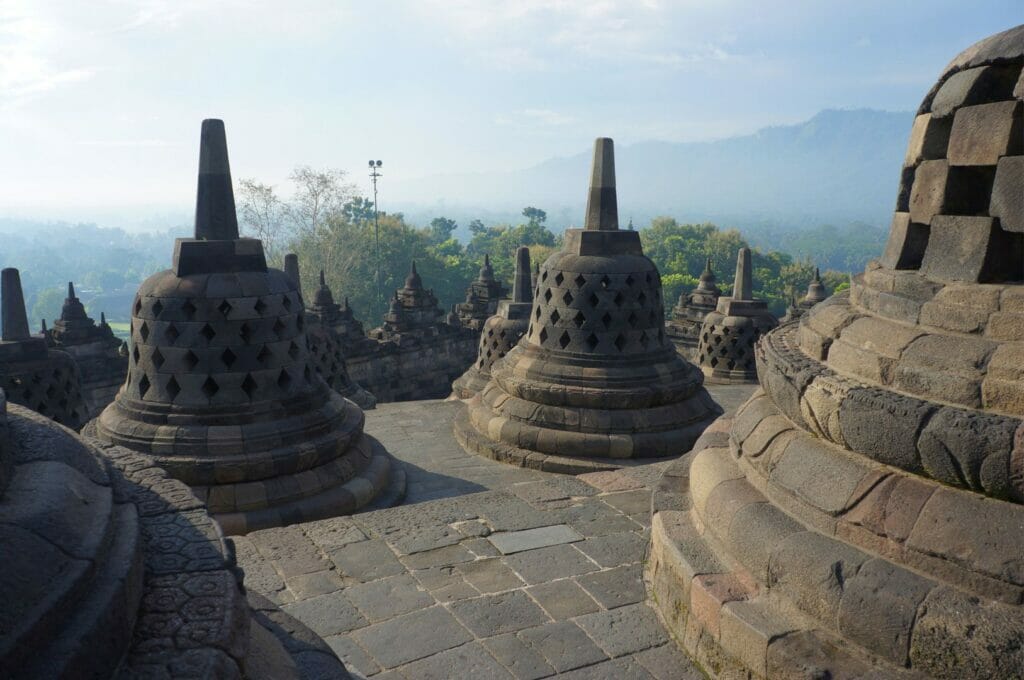
From the rest of Indonesia
Whether you are in Bali, Lombok, Sumatra, or Flores, flying is still the fastest way to get to Yogyakarta. If you have more time and/or wish to travel in a slower way to make the most of Indonesia, you can combine train, bus, and ferry and visit each island crossed. We refer you to the specific articles on Bali and Lombok for these routes.
Note that Yogyakarta has 2 airports: the old one, Adisutjipto (JOG), located east of the city, and the new one, Yogyakarta International Airport (YIA) or Kulon Progo Airport, south of Jogja. Adisutjipto still receives flights from local airlines, you are likely to arrive at the new international airport otherwise.
To reach the city center from the brand new airport, 3 means of transport are possible
- train: this is the cheapest and fastest option! From the airport station, you will have a 40 min ride to Tugu train station. Book your ticket here by selecting Bandara Int. Yogyakarta, or in the ticket offices on site but be aware that the trains fill up quickly. Cost: 20 000 rupiahs per person.
- bus: but we don’t recommend it because the traffic in Jogja is quite heavy. It will take you about 2 hours to get to the city for a minimum of 70 000 rupiahs…
- taxi: as on the other islands, beware of the taxi mafia if you choose this means of transportation. We rather recommend you use a Grab, the local Uber, or Blue Bird taxis. But be aware that the fares are higher (200 000 rupiahs) and the traffic is uncertain…
Getting around Yogyakarta
If your hotel is in the city center, the best way to get around is on foot!
Otherwise, in addition to the bemo, you’ll see a lot of becaks, another typical means of transportation in Yogyakarta. See the rickshaws? Becaks are the Indonesian version. 2 seats are fixed in front of the handlebars and the driver is behind to pedal to take you where you want. There are also motorized becaks for longer distances. Oh and don’t forget to bargain 😉!
Another cheap way is to take one of the Trans Jogja buses, whether you want to reach the city center from Adisutjipto airport (if you fly with a local company) or just visit Yogyakarta’s must-sees (Prambanan, Kraton). You will easily spot the Trans Jogja buses, they are yellow and green! The bus ticket is fixed at 3500 rupiahs per person, whatever your destination. Tip: instead of buying a bus card, pay directly in cash by making the exact change. To help you, here is the map of the Trans Jogja lines.
A last solution is to take a Grab, the local Uber, a Blue Bird taxi, or a private driver.
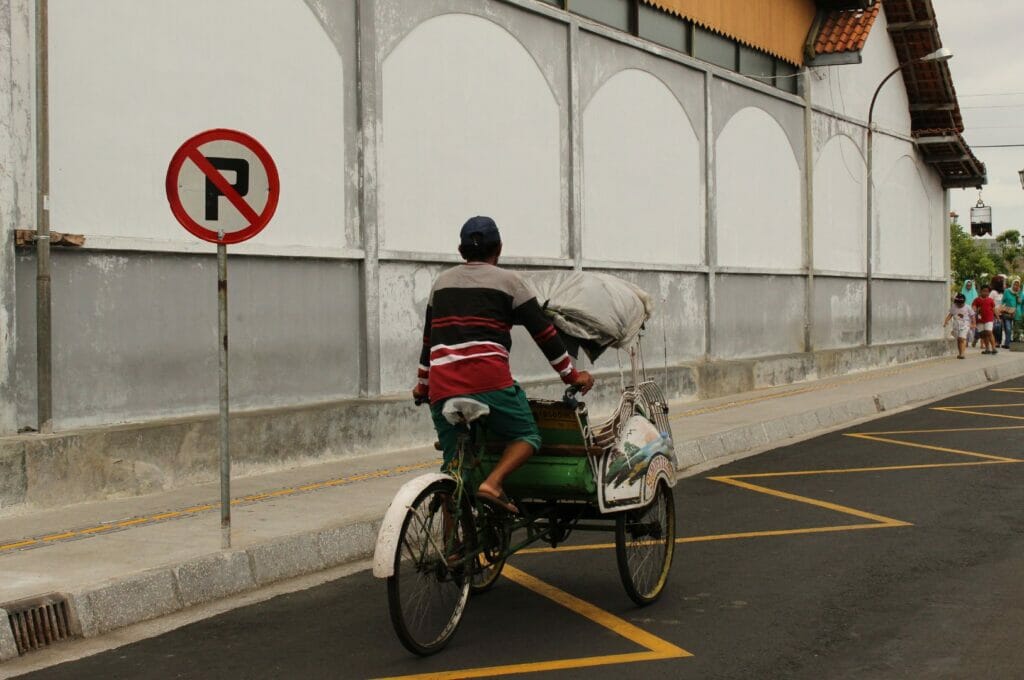
Things to do in Yogyakarta
To be near Fabienne, I preferred not to visit everything in Jogja and concentrate on the Borobudur and Prambanan temples. These last two are the main cause of the tourist influx that Yogyakarta knows. However, the city does not lack interest(s) and here are some tips to visit Yogyakarta in a few days! Find all these points on the map at the end of the article.
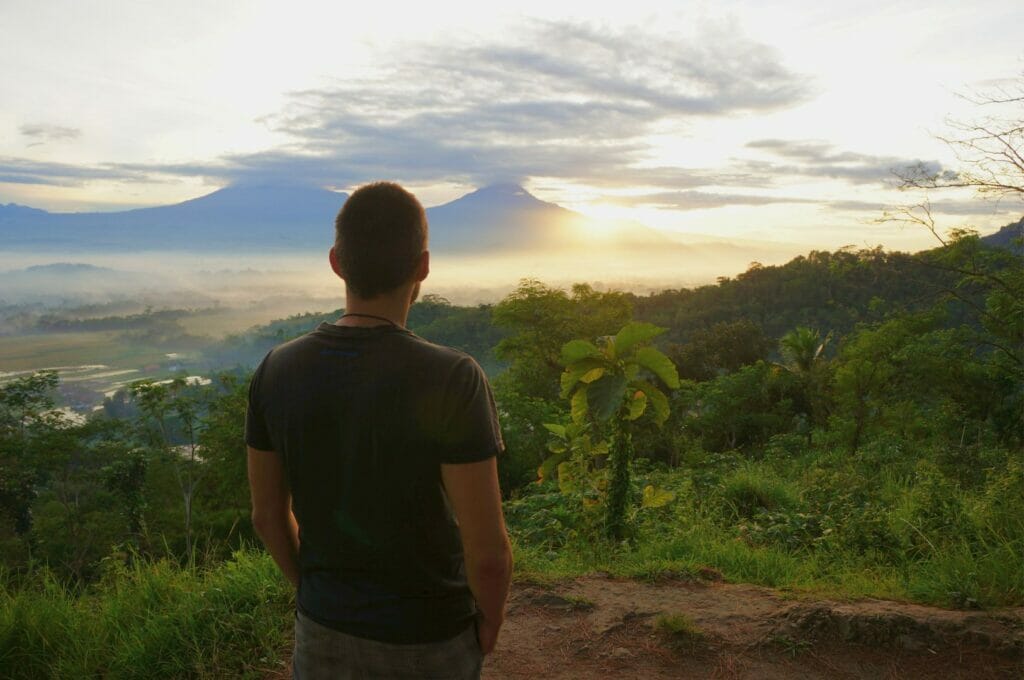
Visit the Keraton (or Kraton), the palace of the sultan
The Keraton is one of the key monuments of Yogyakarta as it is the residence of the sultan of the city, Hamengku Buwono X. In fact, the sultan’s palace is a small part of the Kraton, a kind of huge village surrounded by walls. In addition to this residence, this complex built in 1755 consists of several museums, schools, small stores, and mosques. The palace itself is full of sacred objects, luxurious rooms, kiosks… As the sultan still has his apartments, only a part of the palace is accessible to the public.
The other interest of Kraton Palace lies in the shows that are held every morning between 9 a.m. and 12 p.m. A gamelan concert (the typical Indonesian orchestra) on Monday and Tuesday, traditional dances on Thursday and Sunday, and puppets (wayang) or poems (macapat) and Javanese songs the rest of the week. Admission to the Kraton is set at 15 000 rupiahs and it is open from 8 a.m. to 2 p.m.
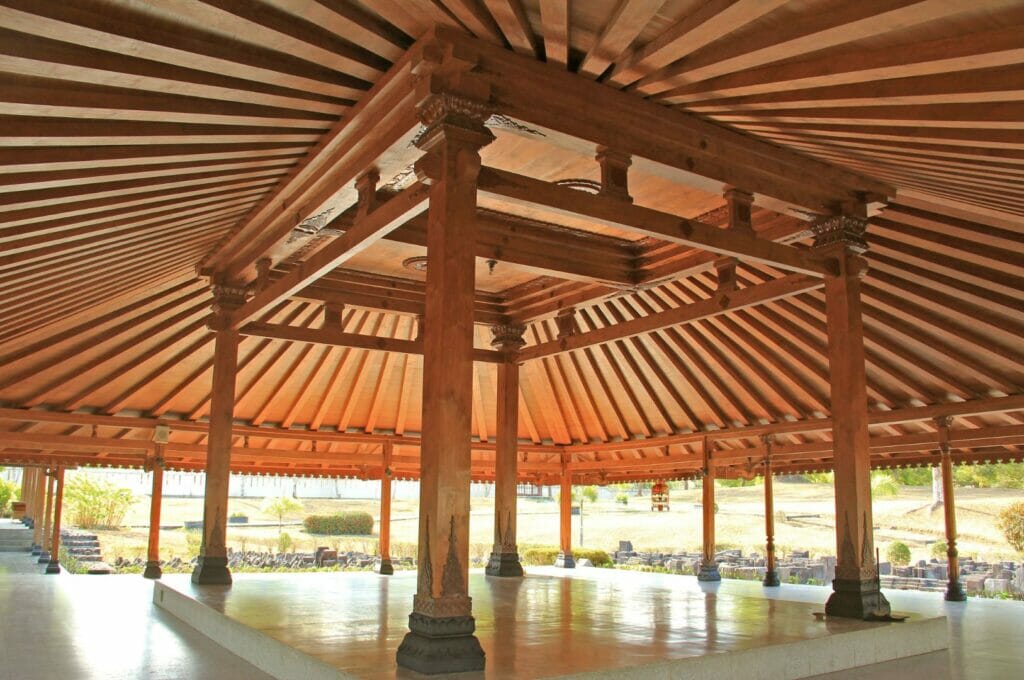
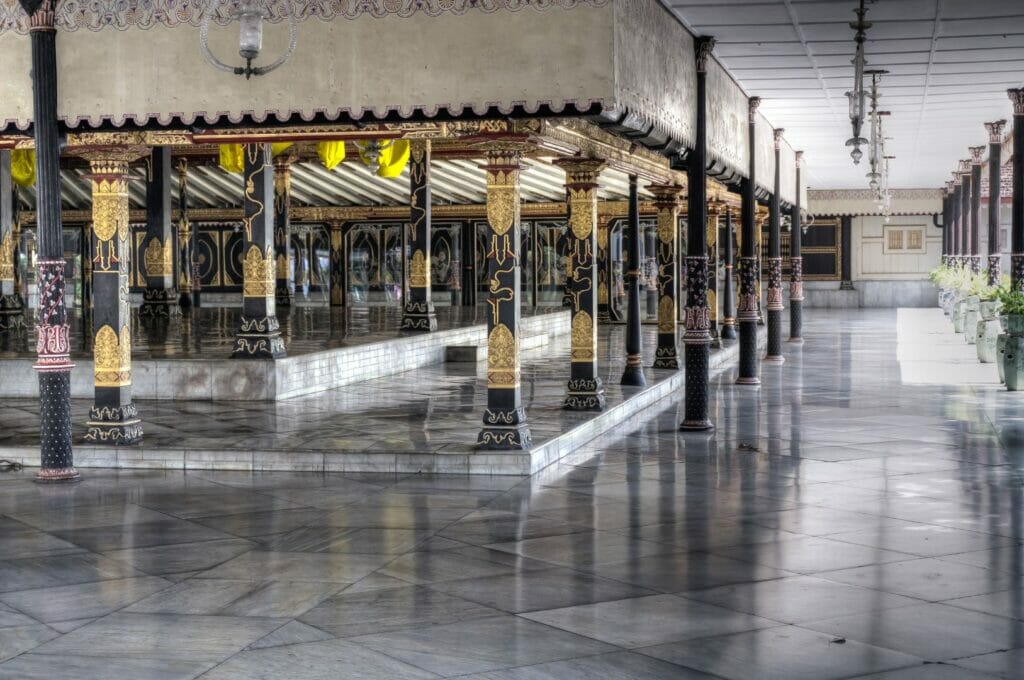
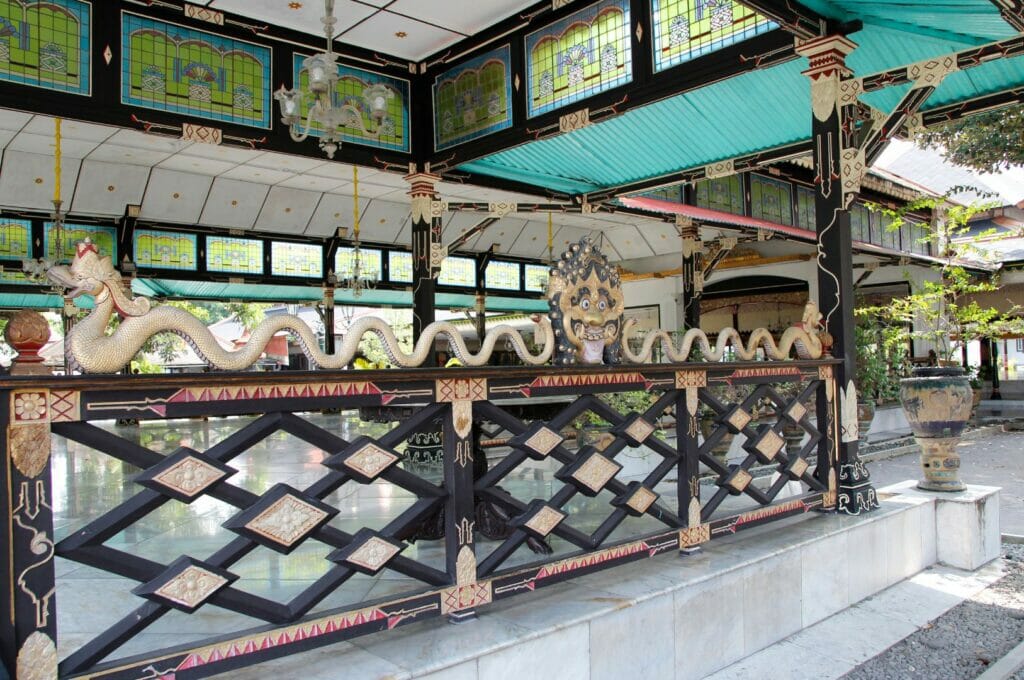
Visit the Taman Sari or Water Castle
Not far from the Keraton is the Taman Sari (or Tamansari), another palace of the sultan but unused nowadays. Built by a Portuguese architect in the middle of the 18th century, it was intended to receive the sultan’s mistresses and to entertain or relax in the pools. The entrance fee is 15 000 rupiahs and it can be visited between 9 a.m. and 3 p.m.
Tip: Beware of the touts around Tamansari, they will want to take you to their batik workshop and will insist heavily that you buy from their store. You can find other places to buy quality batik like Beringharjo market or Malioboro Street.
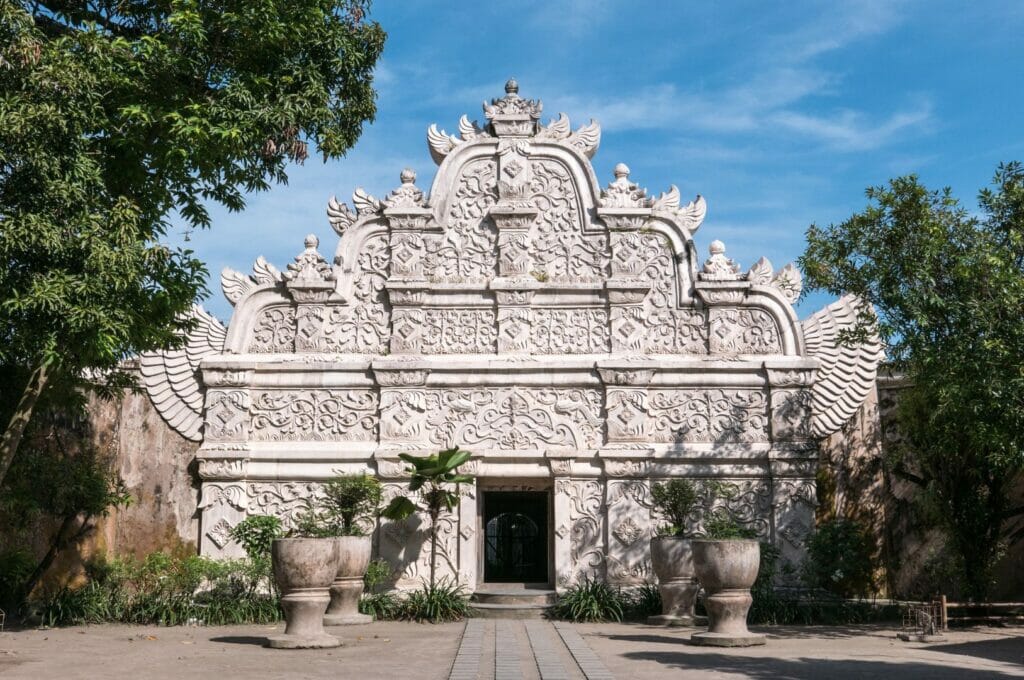
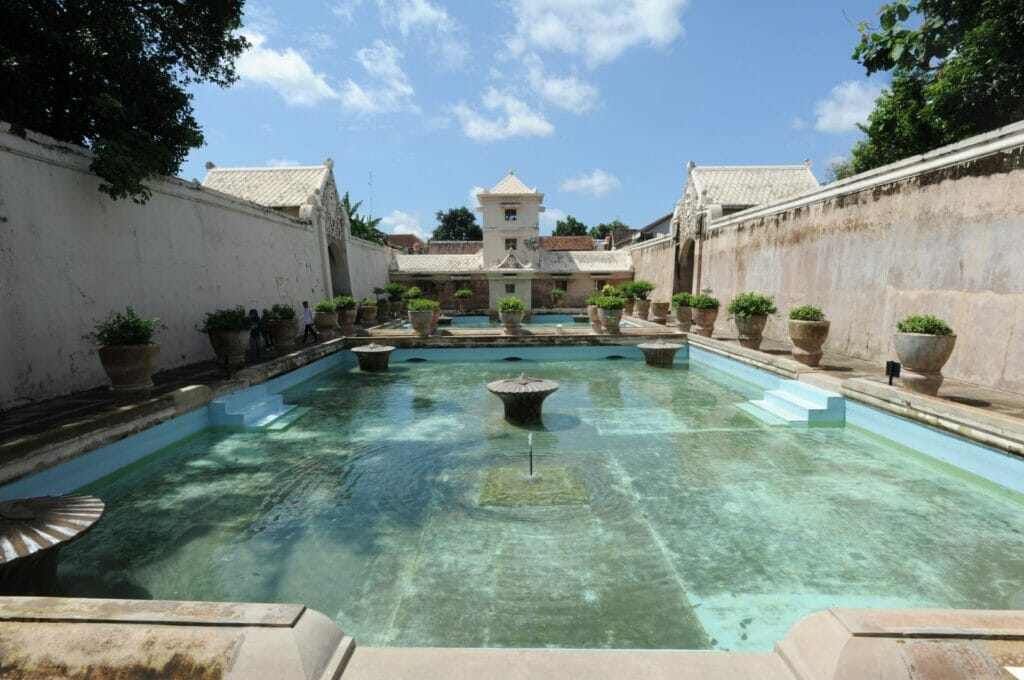
Take a walk in the Pajar Beringharjo market
The Pajar Beringharjo market is the main market of Yogyakarta and probably the oldest since it is open since 1758! It’s simple, you can find everything there, whether it’s food, batik, souvenirs… In short, it’s a place as much appreciated by the locals as the tourists to buy a trinket or to eat. It is open every day from 8:30 a.m. to 9 p.m.
Shopping in Malioboro Street
Malioboro Street (Jalan Malioboro) is often a must-see during a trip to Yogyakarta. This pedestrian street serves many stores and restaurants and comes alive even more when night falls… It looks like Khao San Road in Bangkok… If you’re already doing the Beringharjo market, you can skip Malioboro Street 😉.
Feast at the Pasar Ngasem market
Pasar Ngasem Market used to be a bird market. Yes, literally. There were birds but also other more or less exotic animals in cramped cages… Basically, an open-air pet shop with its share of cruelties that we’ll spare you the details. This bird market has been moved elsewhere in the city but the principle remains the same… You understand why we don’t recommend it.
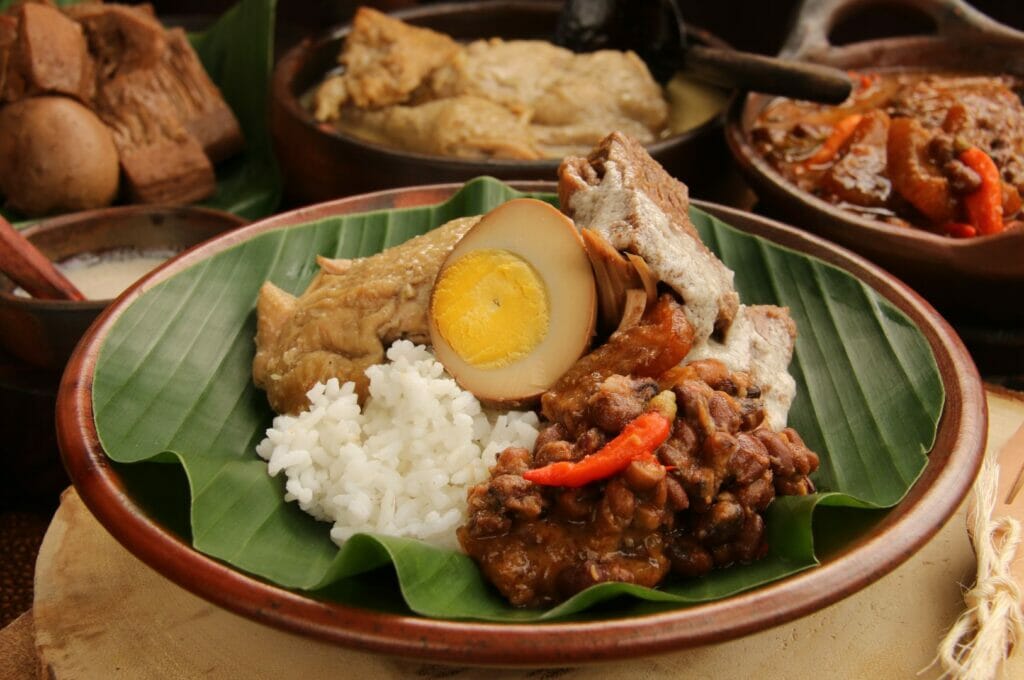
Anyway, let’s get back to the actual market. Today, the Pasar Ngasem market is both a market and a food court where you can find all the dishes of traditional Javanese cuisine! Do not miss the gudeg, a typical dish of Jogja and Central Java! It consists of jackfruit cooked in coconut milk with rice, herbs, egg, and chicken.
In addition to the markets, Yogyakarta City is full of culinary highlights. If you’re an epicurean, Getyourguide offers food tours to quench your thirst (and hunger!) for gourmet discoveries. Stroll through the streets of Jogja and taste the best of the street food. You will also discover all the secrets of the city’s gastronomy.
This article contains affiliate links to partner sites. When you use our links to book accommodation, a car, or an activity, you don’t pay anything extra, but we get a small commission. This helps us to offer you free, independent, and ad-free content. Thank you for your support!
Other activities in Jogja
Here are some other ideas of what to do in Jogja to discover the cultural capital of the island:
- drive a refurbished Volkswagen Kombi decorated with neon and LED lights featuring Hello Kitty or unicorns! Yes, you read that right! Taking a ride in one of these pedal cars is one of the locals’ favorite early evening activities! For this, go to Alun Alun Kidul Park, south of Yogyakarta.
- take up a local challenge, the Masangin: again at Alun Alun Kidul Park, a legend says that if you cross the square and pass between the two banyan trees blindfolded, then you will see your wish come true.
- try your hand at batik: some workshops offer batik classes to learn the basics of this traditional technique that is part of UNESCO’s intangible heritage.
- get lost in the small streets of Yogyakarta and discover Javanese street art.
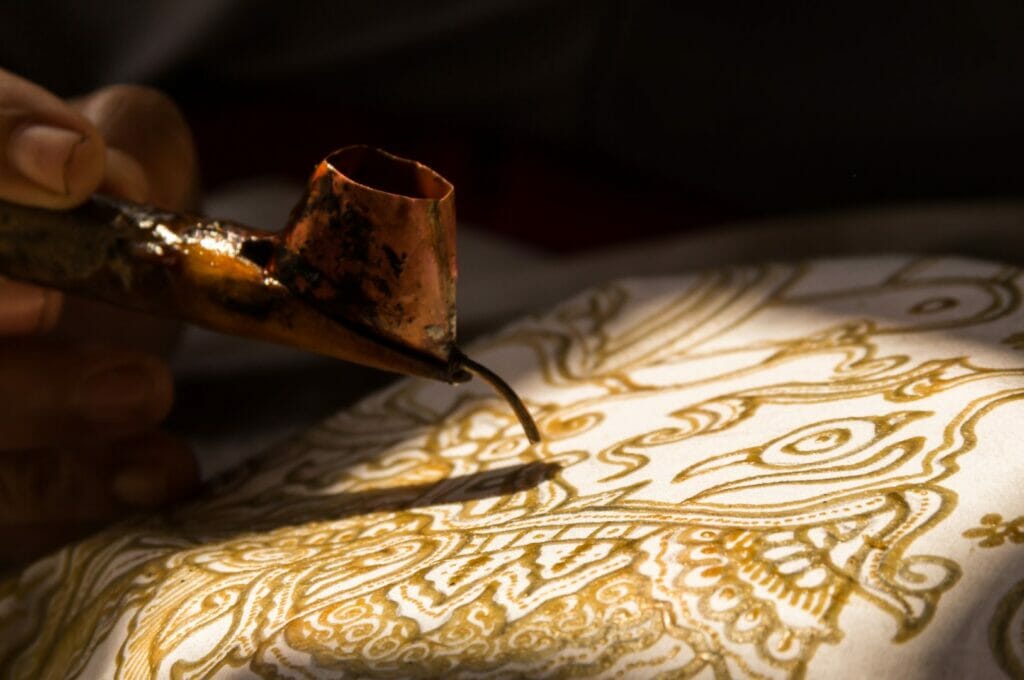
No need to say, there are hotels for every budget in Yogyakarta! Prefer an accommodation close to the center to do most things on foot. For less than 200 000 rupiahs a night, you will find hotels that are more than decent and well-located! If you want some privacy and a great breakfast, then the NOMORE guesthouse is for you! If you are more of a hostel, the Ngampilan Backpacker Hostel offers a very low price: 85 000 rupiahs per person!
Things to do around Yogyakarta
For once, I decided to take a driver with a French couple so as not to lose too much time in transportation and to couple the visit to Borobudur and Prambanan temples in one day. If you are more flexible in terms of timing, you can easily rent a scooter in town (80 000 rupiahs/day) and visit the surroundings of Jogja at your own pace. We have listed all the activities in the area on a map. Go to the bottom of the article!
Watch the sunrise over the Yogyakarta plain
After a full day of well-deserved rest, I decide to get up early again. Waking up at 3:30 a.m. to see the sunrise over the Yogyakarta plain is a little hard! At 3:50 a.m., I am in front of the hotel and the driver is already waiting for me. He speaks very good English and has a hell of a chat, which tends to make me a little suspicious!
We go to look for the French couple to then direct us towards a corner that “only he knows” and which should put us in full eyes for the sunrise. To my biggest surprise, our driver did not lie and we are indeed all alone with an incredible view of the volcano Merapi, Mount Merbabu, and the plain of Yogyakarta. I took one of my favorite pictures of the trip so far.
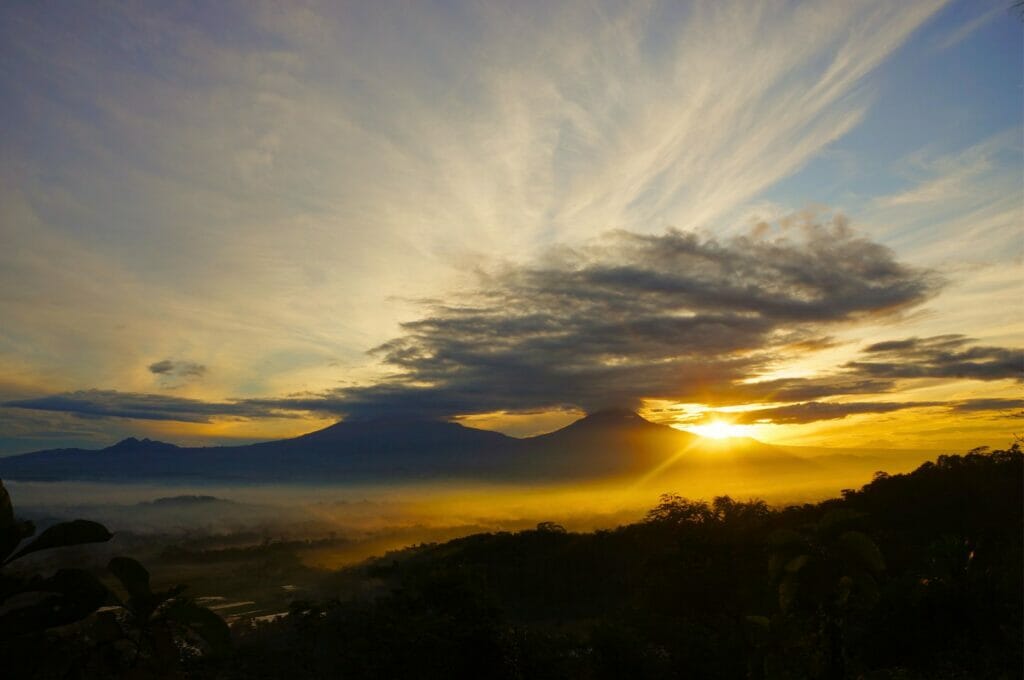
The place where we were was not the Punthuk Setumbu hill, which is rather to be avoided because there are a lot of people and the entrance is paid. We were rather located between Gunung Kunir and Punthuk Mongkrong and we could quietly drink a coffee and eat our breakfast with this crazy view… Perfect!
Here are some other spots to see a great sunrise on the Merapi volcano, the Jogja plain, or on the surrounding landscapes:
- at the top of Gunung Andong, at 1721 m of altitude, after a short night hike accessible to all;
- on top of the Merapi volcano, we detail everything here;
- at the top of Mount Merbabu after the night ascent to 3145 meters of altitude;
- Gunung Telomoyo, at 1894 m of altitude, accessible by two-wheelers (15 000 rupiahs of entrance fee per person);
- Suroloyo Peak, be careful the way can be a little difficult by scooter because of the slope;
- the Plaosan temple (Candi Plaosan): it opens only at 7:30 a.m. but you can admire the first lights that color the site from the rice fields located just next to it, to the west;
- Puncak Kebun Buah Mangunan, south of Yogyakarta: here the sun illuminates the valley. There is an entrance fee of 7000 rupiahs/person.
It was possible to buy a sunrise tour to admire the sunrise from the top of the Borobudur temple. To preserve the site from mass tourism, it is now forbidden to go there before 8 a.m. but this can change depending on the time of the year.
Another option: ask the locals or your hotel, they will surely give you some tips to enjoy the dawn!
Visit the Borobudur temple
After having enjoyed this view, we set off again in the direction of the Borobudur temple in the province of Central Java, 40 km northwest of Jogja. Small historical point: Borobudur is one of the biggest Buddhist temples in the world! Built around the 9th century, the site was then abandoned, then covered by ashes and vegetation before being rediscovered by a British governor, 10 centuries later!
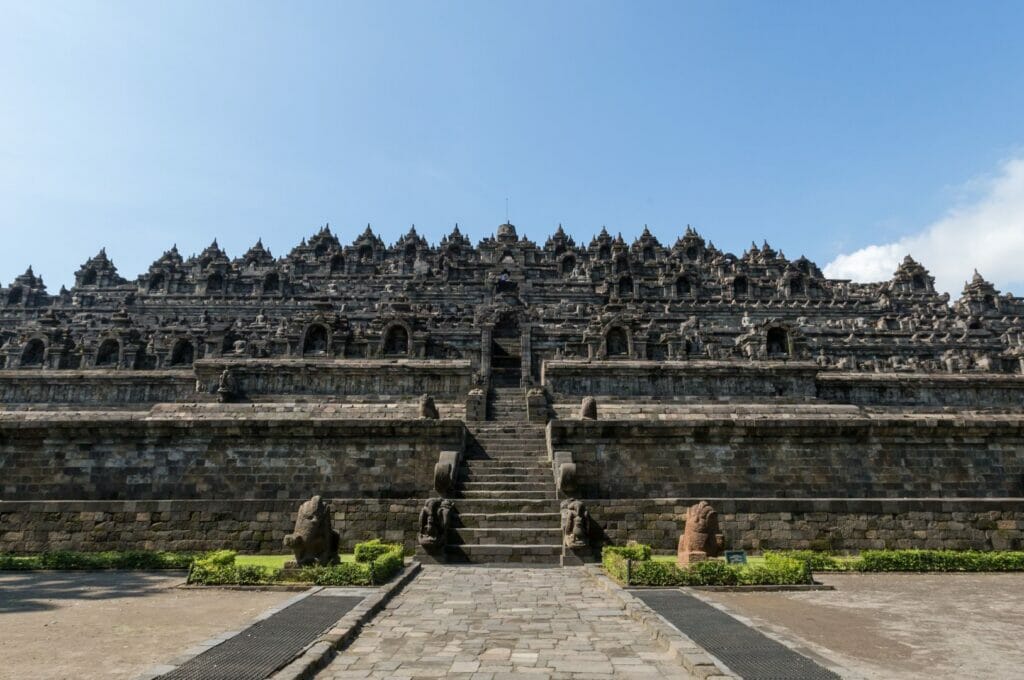
Actually, I had never seen a temple with such an architecture before. It’s even hard to describe! The Borobudur temple is a kind of pyramid or stupa, with 6 first square levels and 3 last circular ones. Seen from above, the structure represents a mandala from Buddhism. More than 2600 bas-reliefs cover the whole! The last circular floors are particularly interesting because it is at the top that we find several hundreds of niches and stone bells containing statues of Buddha in the lotus position.
There is a very particular atmosphere in Borobudur. We arrived there early in the morning and there were just a few people who were there to meditate. The environment is quite nice! At the beginning of the day, the place is extremely zen and I took a lot of pleasure to discover the corners of the temple. However, the place lost some of its charm when the first groups of Chinese arrived with their speakers. They even scared away the people who were meditating…
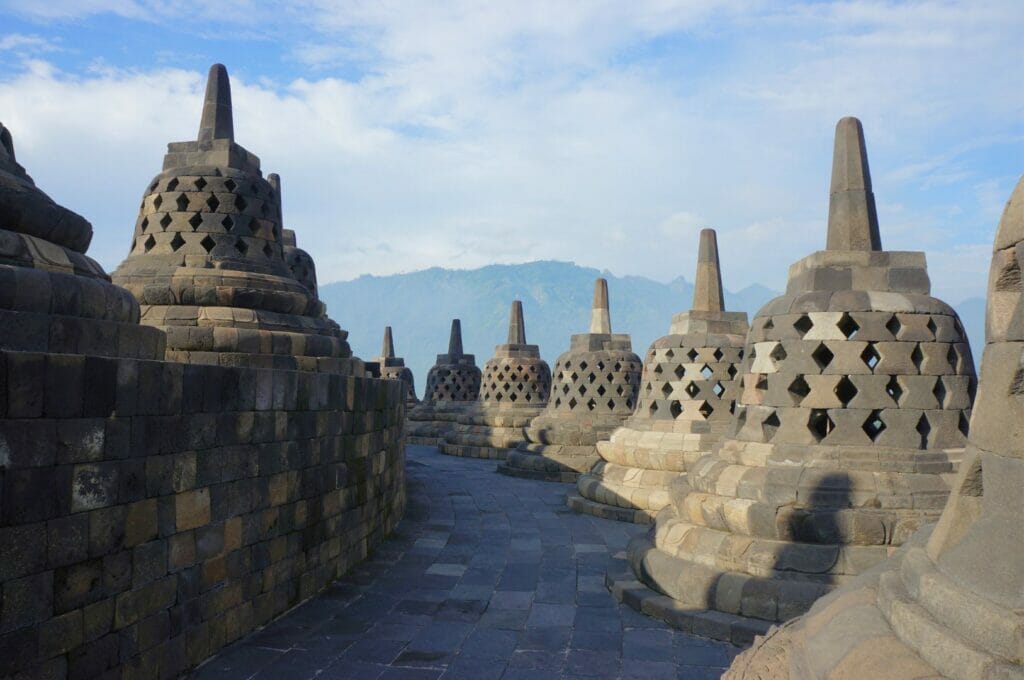
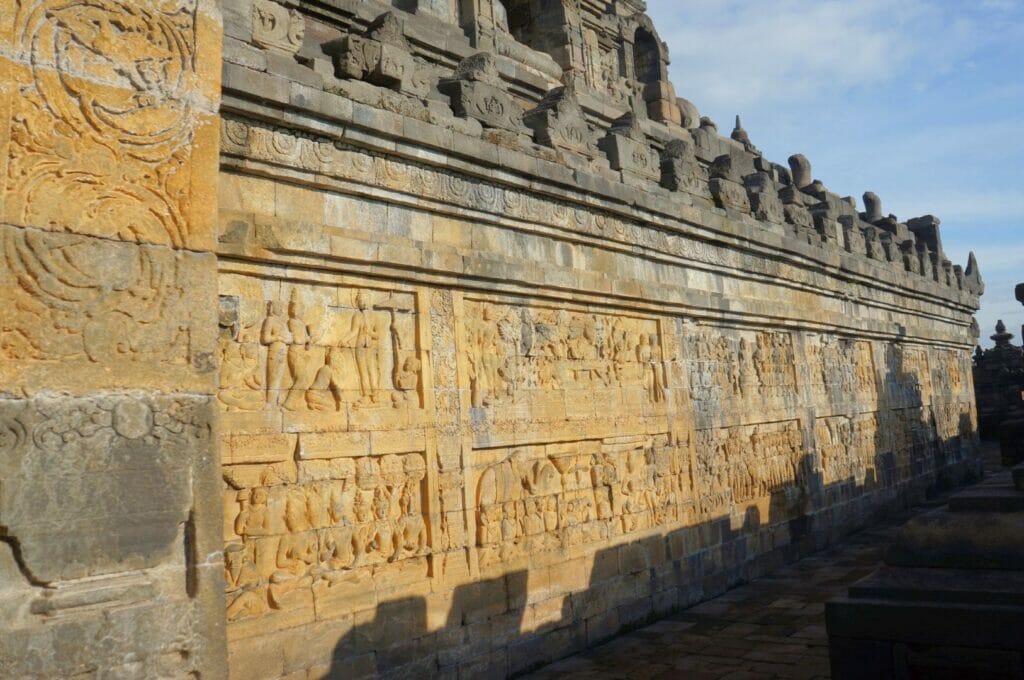
To get to the Borobudur temple from Yogyakarta, you can go there independently by renting a scooter or by taking a driver who will take you where you want. Another option is to take a tour of Borobudur only or to combine its visit with Prambanan.
For several years, Indonesia has been a victim of mass tourism and the Borobudur temple is the first to suffer the effects… Indeed, it is the most visited site in the country with no less than 4 million visitors annually before the pandemic. To preserve this historic site, which is a UNESCO World Heritage Site, the number of visitors is now limited to 150 per hour and 1200 per day. Attention: the Borobudur temple opens at 8:30 a.m. but it is closed on Mondays! We strongly advise you to visit it at the opening for more tranquility.
Be aware that there are two tickets to buy. The first one gives you access to the site and the second one gives you the right to enter the temple of Borobudur to which you have to add the fees for a guide. You can pre-book your ticket here and then exchange it for the ticket giving you the right to enter the compound. You can buy the other ticket here to have the services of a guide who will take you to Borobudur. This saves you from waiting in line (and scams) and you are sure to have a good guide who will give you all the information about the temple.
As mentioned above, access to the top of Borobudur temple is forbidden to watch the sunrise. However, note that it can also be inaccessible the rest of the day… In case of authorization, you will have to pay a supplement to climb to the top. Another point that can be a bit infuriating: don’t be surprised by the difference between the rates for Indonesians and foreigners, they are 7 times cheaper 🙃.
Visit the temples of Prambanan and enjoy the sunset
Located 16 km east of Yogyakarta, the Prambanan complex is the largest Hindu temple complex in Indonesia. It consists of 500 buildings including the Sewu, Bubrah, Lumbung, and Prambanan temples.
The most impressive is the Prambanan temple, consisting of over 240 buildings. The three main ones are dedicated to the Trimurti, the triple manifestation of the Supreme Being represented by the gods Brahma, Vishnu and Shiva. A little further north, go to the Sewu temple, the second most remarkable temple on the site. As it is a little off-center, the crowd is less. Sewu is the only Buddhist temple of the Prambanan complex and it is the second most important in the region after Borobudur!
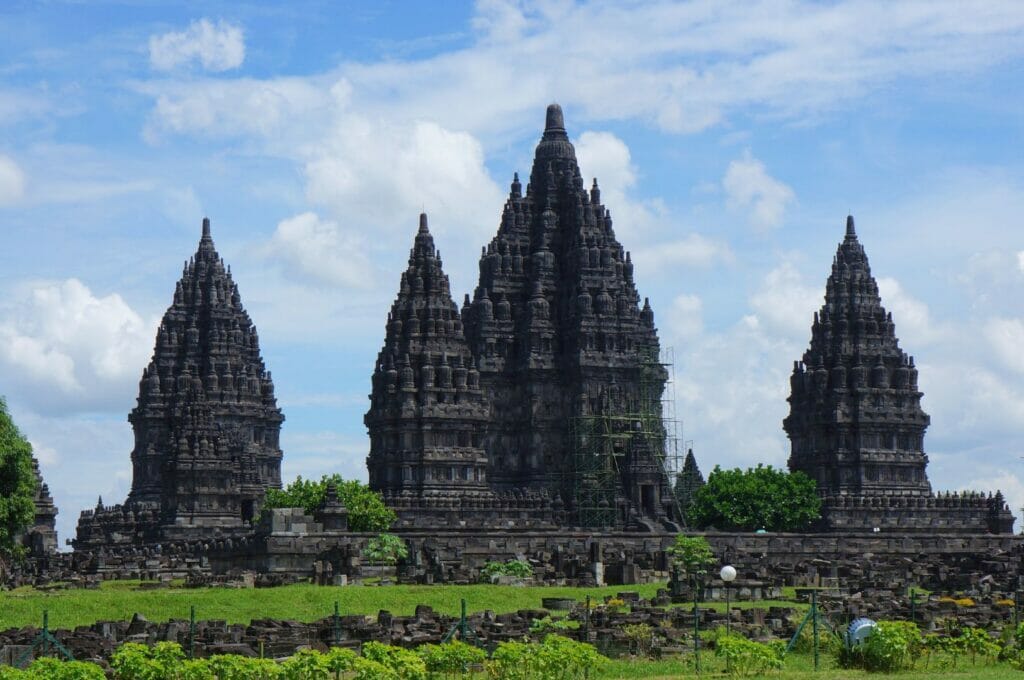
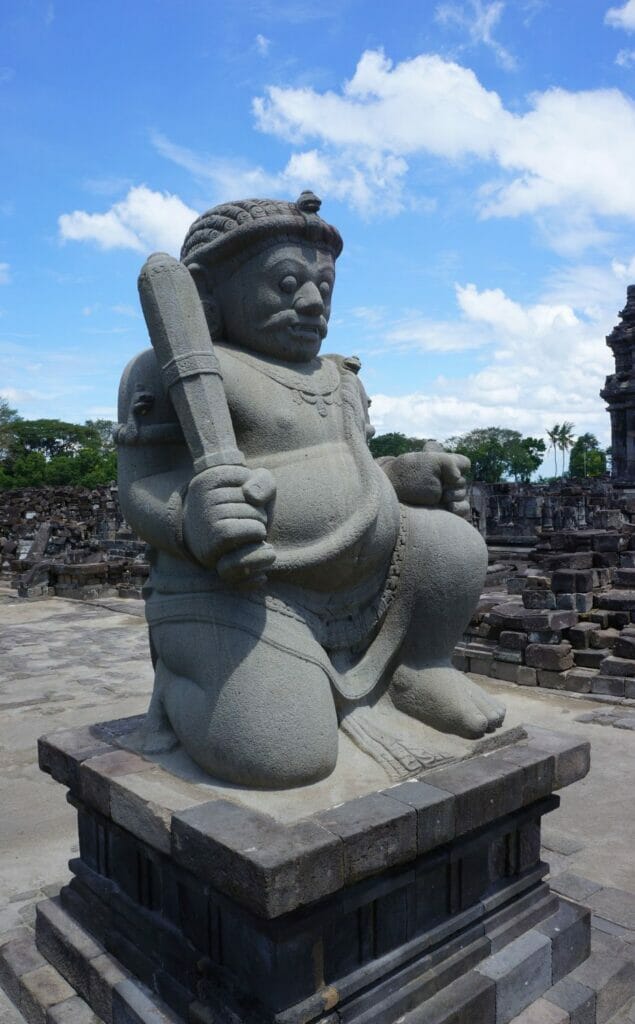
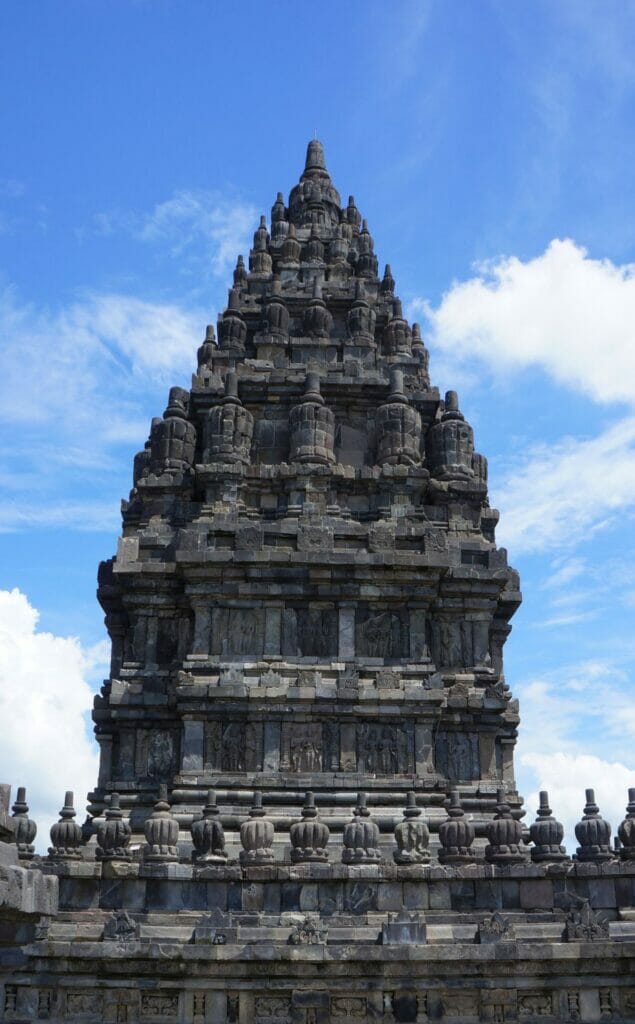
To be honest with you, the whole thing impressed me less than the Borobudur temple… Their architecture reminded me a bit of the Angkor temples, even if I know that it is not the same thing. Moreover, because of earthquakes and eruptions, the complex is well-damaged, which implies quasi-permanent renovations. During my visit, there was scaffolding everywhere and despite my efforts to ignore it, it somewhat spoiled the experience.
That said, given the tourist development around Borobudur, we can prefer Prambanan temple for its quietness…
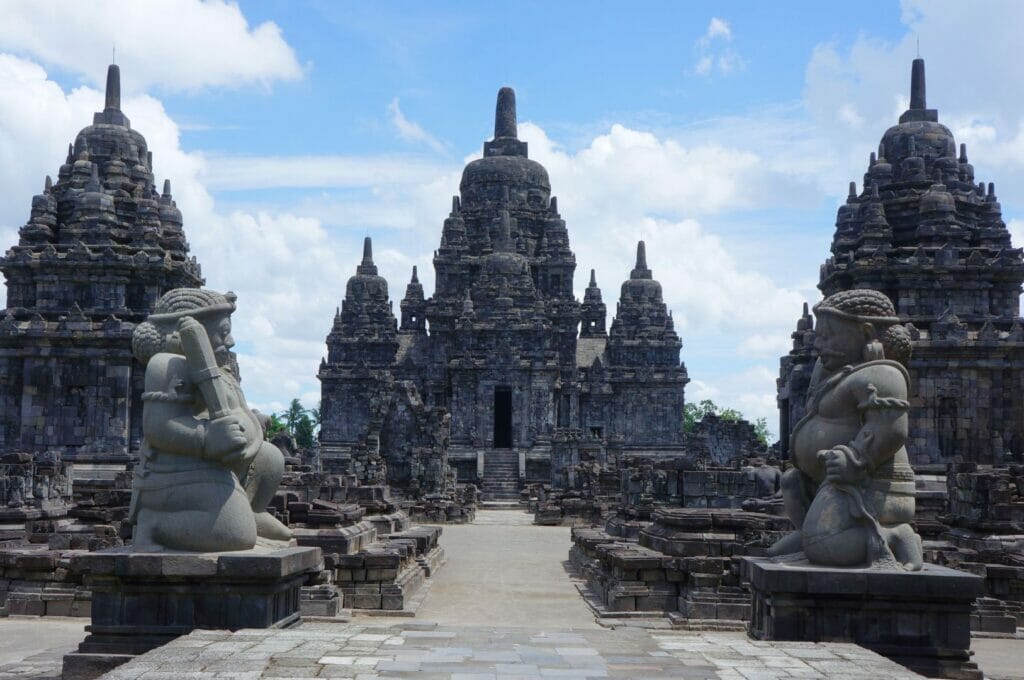
To reach the Prambanan temple from Jogja, the best is to take the 1A line of the Trans Jogja bus. For more freedom, rent a scooter, take a private driver for the day, or book a guided tour at sunset!
Prambanan is open from 6:30 a.m. to 5 p.m. and also closed on Mondays.
Like Borobudur, you can buy your ticket to Prambanan online. Here, there is only one ticket and the guide is not mandatory but there are few explanatory signs so it is up to you! Know that there is a combined ticket to see Borobudur and Prambanan at 652 500 rupiahs each, valid for 48 hours, that you can buy on the spot at both. Be careful, it does not include the extra fees at Borobudur to access the temple and the services of a guide!
Do you remember when I told you that our driver seemed too nice? He actually lied to me saying that there was no combo ticket and that he could provide me with the tickets at the same price as a ticket sold separately to avoid me waiting in line. I realized the scam only after visiting Borobudur. As a result, I had to fight hard to get him to agree to give me back the difference from the price of the combined ticket! We didn’t separate as best friends in the evening but well, after a while, I’m tired of being ripped off!
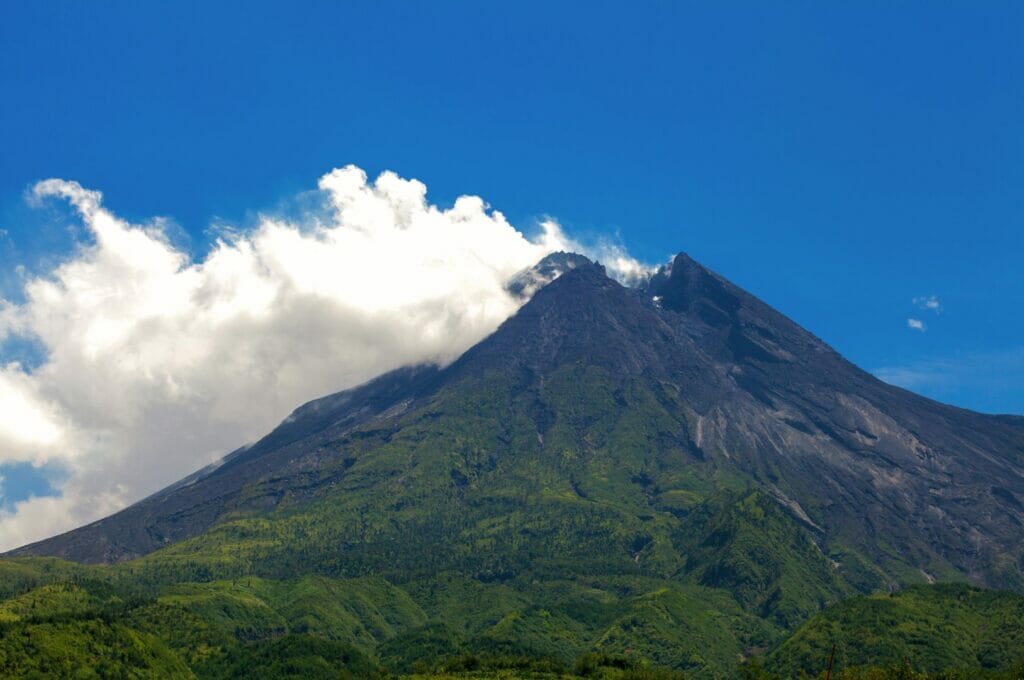
Climb the Merapi volcano
Gunung Merapi is the most active and dangerous volcano in Indonesia. Culminating at 2930 m of altitude, this “mountain of fire” is unfortunately often talked about. Its last big eruption dates back to 2010 when it killed several hundred people… Nevertheless, local and foreign trekkers do not hesitate to climb the Merapi volcano when conditions allow it! Before you plan your trip, check out the information on current eruptions.
To climb Mount Merapi, you must go to the village of Selo, north of the volcano, about 50 km north of Jogja. Here, you have the choice to take a guide to climb on the giant or to make the ascent independently, whether for the sunrise or not. Beware that if you are not adept at this kind of hike, we advise you to take a guide on the spot! Otherwise, the path is quite well-defined. As the volcano is in the center of the eponymous national park, there is an entrance fee. Count 4 hours to reach the summit for a little more than 1000 m of ascent! To download the map of Merapi, click here.
To give you an idea of the hike, we invite you to read the article by Eoghan and Jili.
Climb Mount Merbabu
Mount Merbabu is an extinct volcano, a neighbor of Merapi and a little bit higher (3145 m of altitude). This “mountain of ashes” is a little less popular compared to the latter and yet the view from its summit is also breathtaking!
It is possible to make the ascent independently to attend the sunrise but many locals come to climb in late afternoon to camp on the Merbabu. This way, they can enjoy both the sunset and the sunrise from the summit!
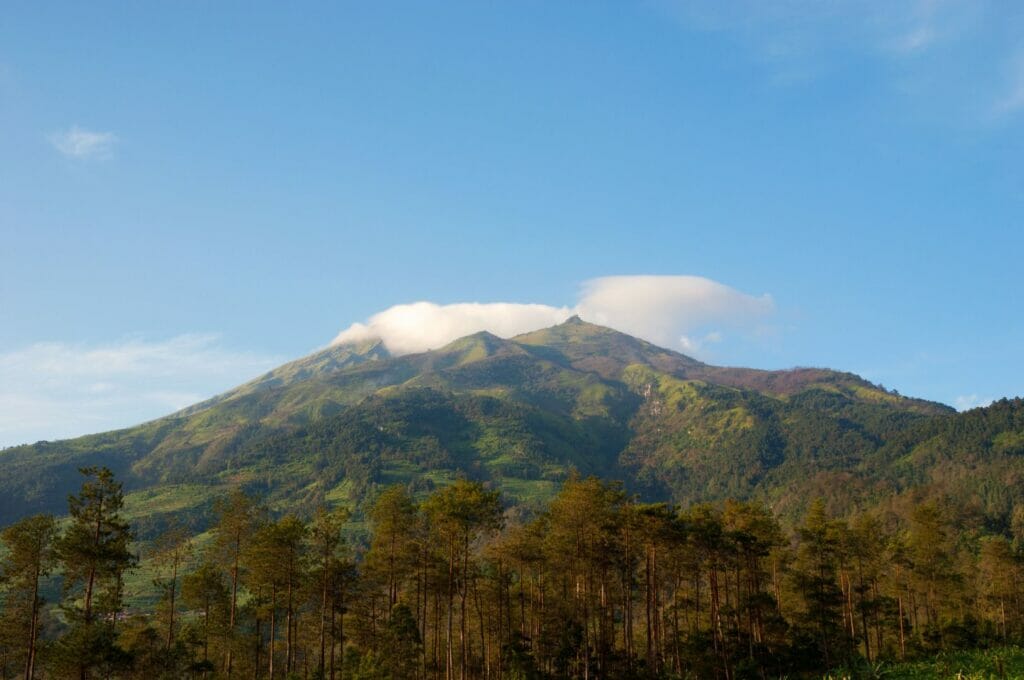
To start the hike, you have the choice between Selo in the south, Thelekan, Cuntel, and Wekas in the north, and Suwanting in the west. The most convenient is the trail from Selo because it is shorter and better marked due to its popularity. Moreover, it allows you to do the ascent in one go if you do not want to camp for the sunset. Otherwise, opt for the organized Merbabu tour from Yogyakarta where you will have a guide and all the equipment for 2 days/1 night on the volcano! When entering the Gunung Merbabu National Park, you will have to pay an entrance fee. It takes about 5 hours to get to the top and to climb 1300 meters! Download the map from Selo here.
Find more information about the Merbabu hike in Elliot’s article.
Other activities around Jogja
You will have understood that Jogja is not limited to Borobudur and Prambanan! Come on, we give you some inspiration to continue your trip:
- visit the Mendut temple: near Borobudur, the small Candi Mendut temple contains a statue of a seated Buddha and next to it, you can visit a beautifully treed Buddhist monastery;
- bike around Yogyakarta to immerse yourself in the daily life of the Javanese;
- discover the history of Yogyakarta and Javanese culture at the beautiful Ullen Sentalu Museum: admission starts at 50 000 rupiahs and includes a guide;
- enjoy the beaches south of Jogja: the most popular is probably Pantai Parangtritis, 30 km from the city center but feel free to go along the coast if you want to be quieter, especially on weekends;
- visit Candi Selogriyo in the middle of the rice terraces: this temple is an excuse to admire the beautiful rice terraces and contemplate the landscape.
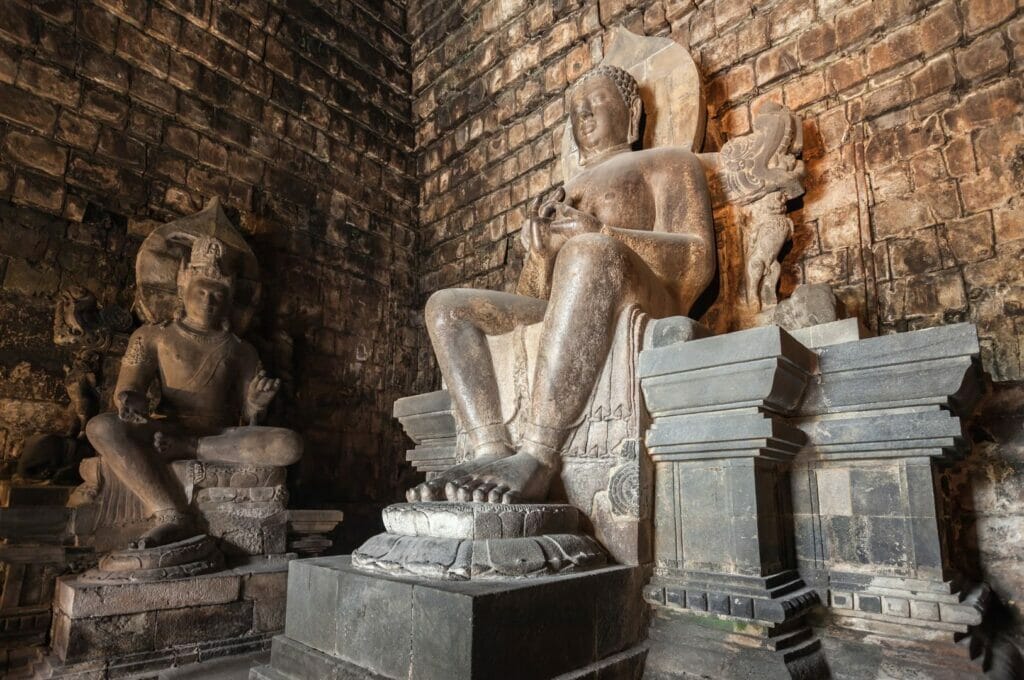
Map of Yogyakarta
Here is a map of the region to see at a glance all that there is to do and see in Jogja!
End of our trip in Indonesia and the worst bus trip…
As I told you, we did not see much more of Yogyakarta because Fabienne was stuck in bed and we had our plane in Jakarta. To save a night hotel, we wanted to travel by night and thus two solutions were offered to us. The safe solution is the train! They are of great quality on Java but the night trains are a bit expensive. The cheap solution is the bus! You can guess which one we chose, right?
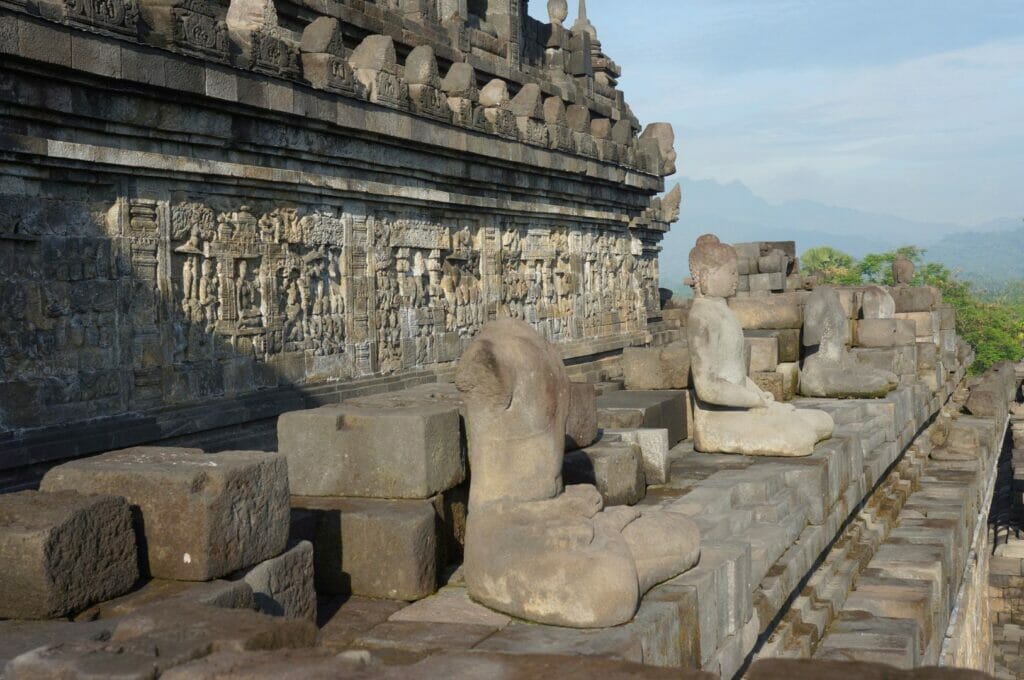
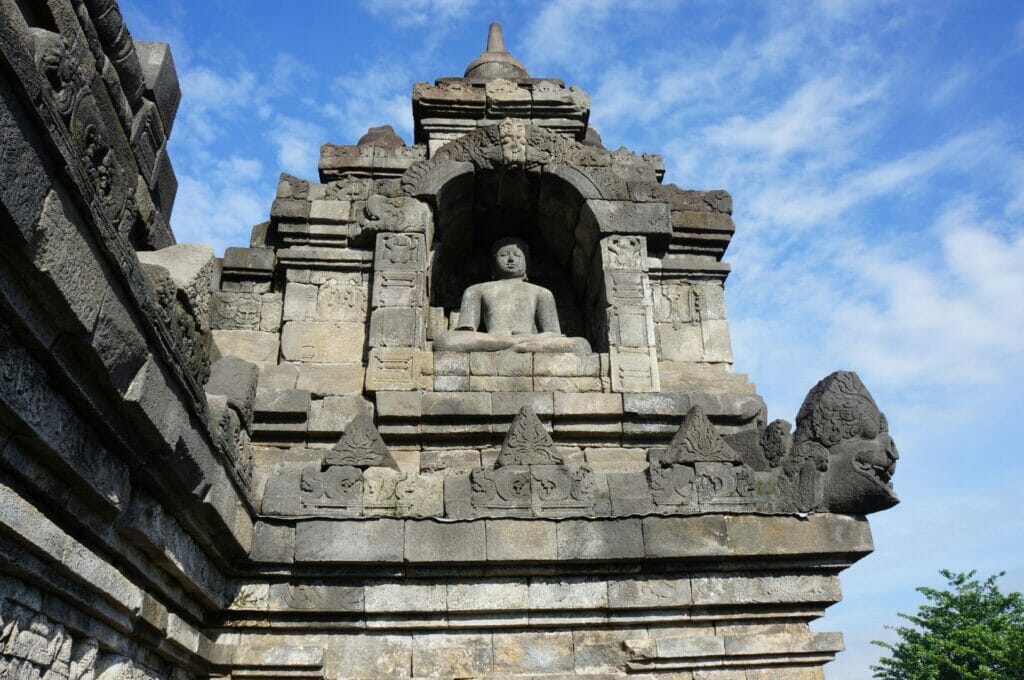
The bus from Yogyakarta to Jakarta
Technically, this bus trip should have been easy. The roads on Java are in excellent condition and there are about 15 hours of travel. Nothing really bad! Moreover, seen from the outside, our bus seemed to be top-notch. However, we were far from imagining the rest of the program!
Well, while sitting on the bus, I still noticed some cockroaches and ants. Honestly, we have seen worse. In the middle of the night, after 5-6 hours on the bus, Fabienne wakes me up and tells me that she has been stung everywhere. I don’t think twice and take out the headlamp and what do I see? BED BUGS EVERYWHERE IN THE SEATS! Awful!
Unfortunately, we had to deal with these bugs twice during our trip around the world. Each time, it ended up in bites all over our body and our stuff washed at 60 degrees.

But here, it was even worse! Finally, it took 23 hours to arrive in Jakarta by bus! You can imagine that we didn’t sleep a wink… To give you an idea of the extent of the damage, here is a picture of my back once at the airport. And this, everywhere on the legs and arms. Terrible! I can promise you that with our bodies covered with bites and Fabienne’s infection, we were happy to find civilization in Sydney!
Our review of Indonesia
So there you have it, as you can see, we ended on a high note 😉. But it would have taken much more to tarnish our impression of this incredible country! In short, we loved everything: the volcanoes, the beach, the Indonesians… We are already looking forward to coming back to discover Flores, Sumbawa, Komodo… We’ll see you for the last article, the one about the budget for a trip to Indonesia, an article that Fabienne has the secret!
Pin it

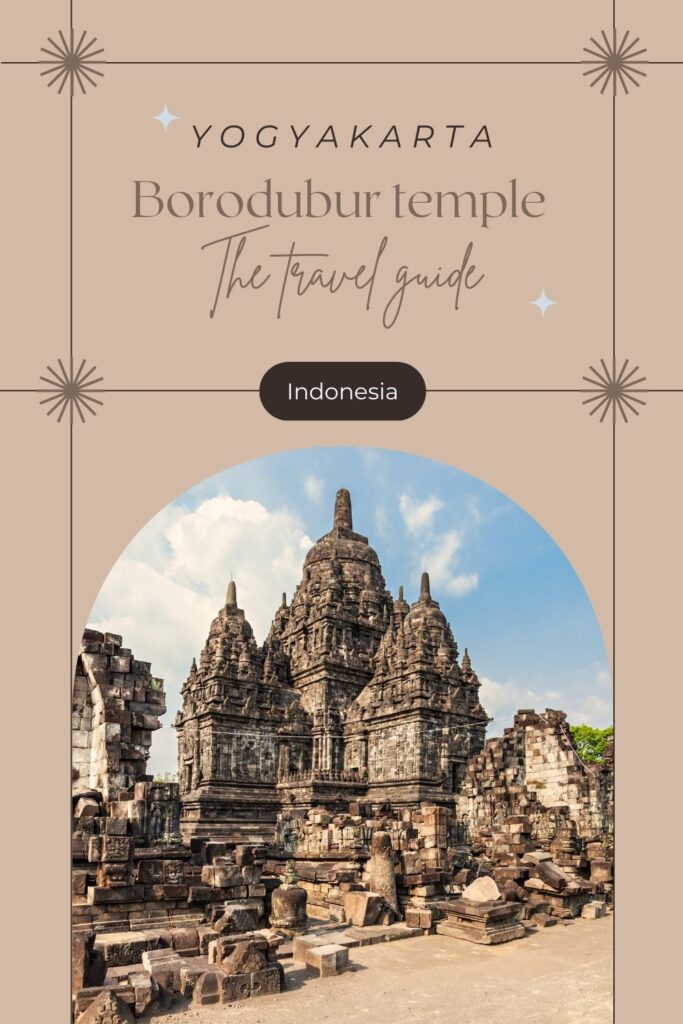
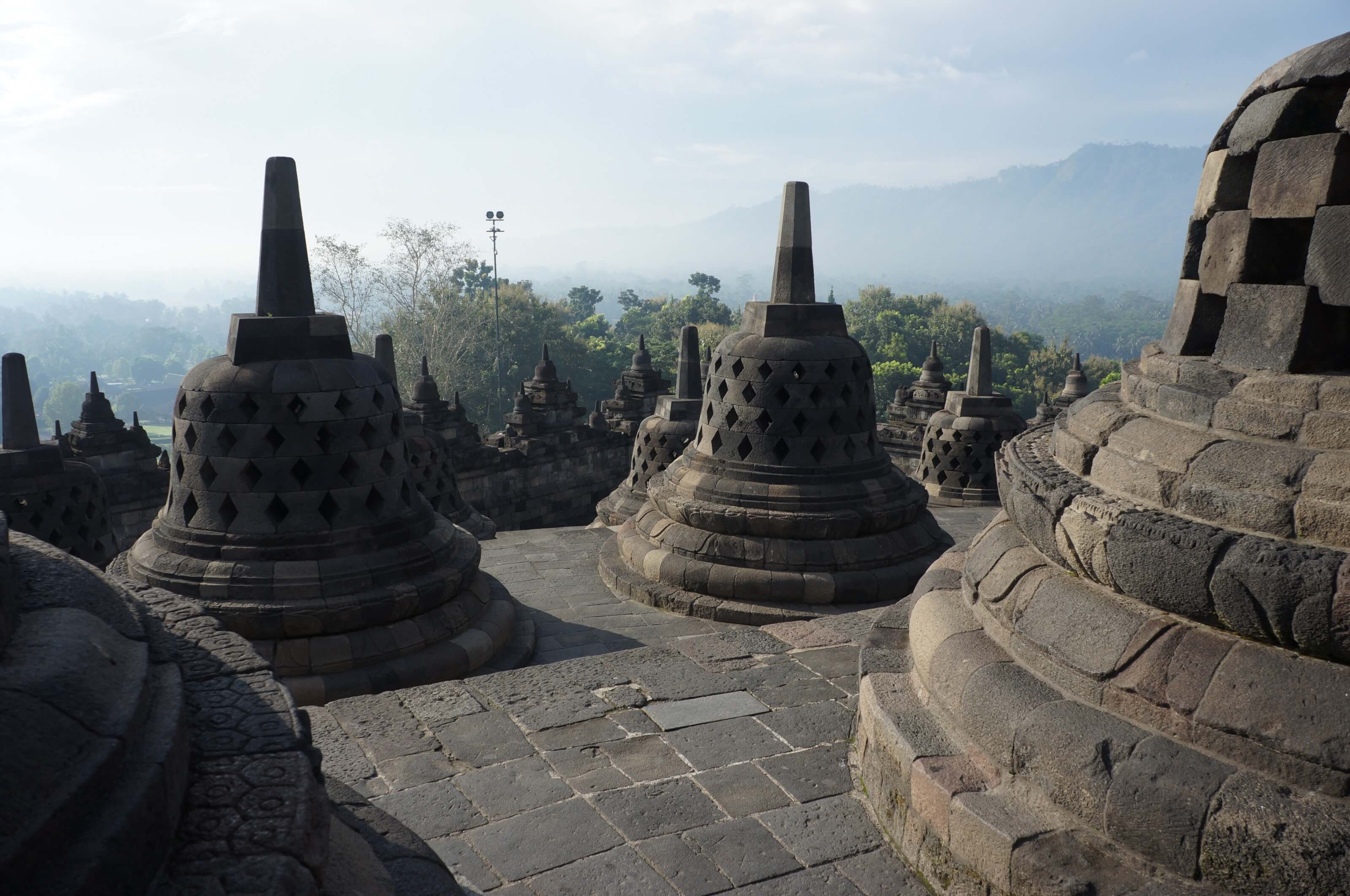
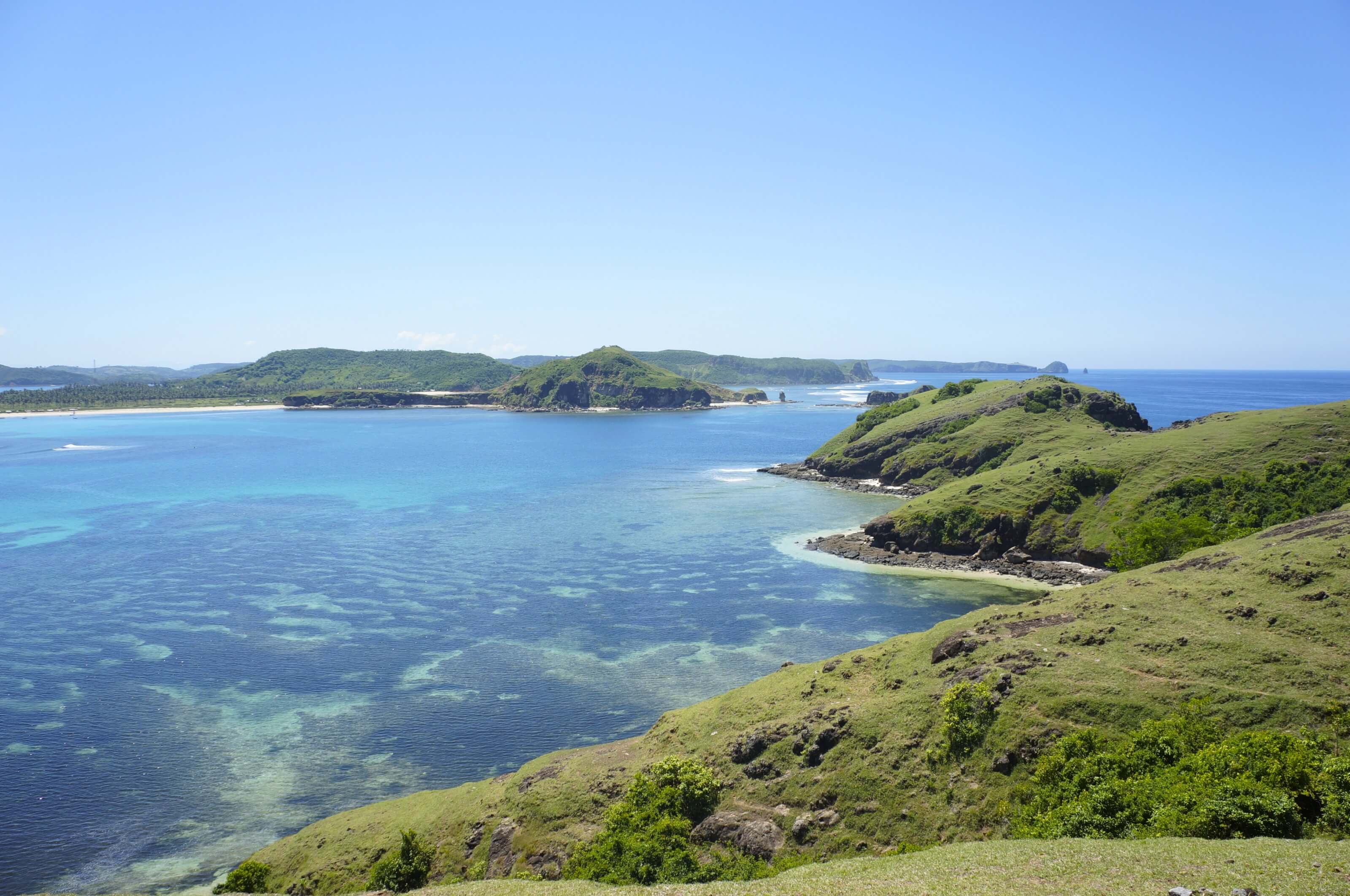
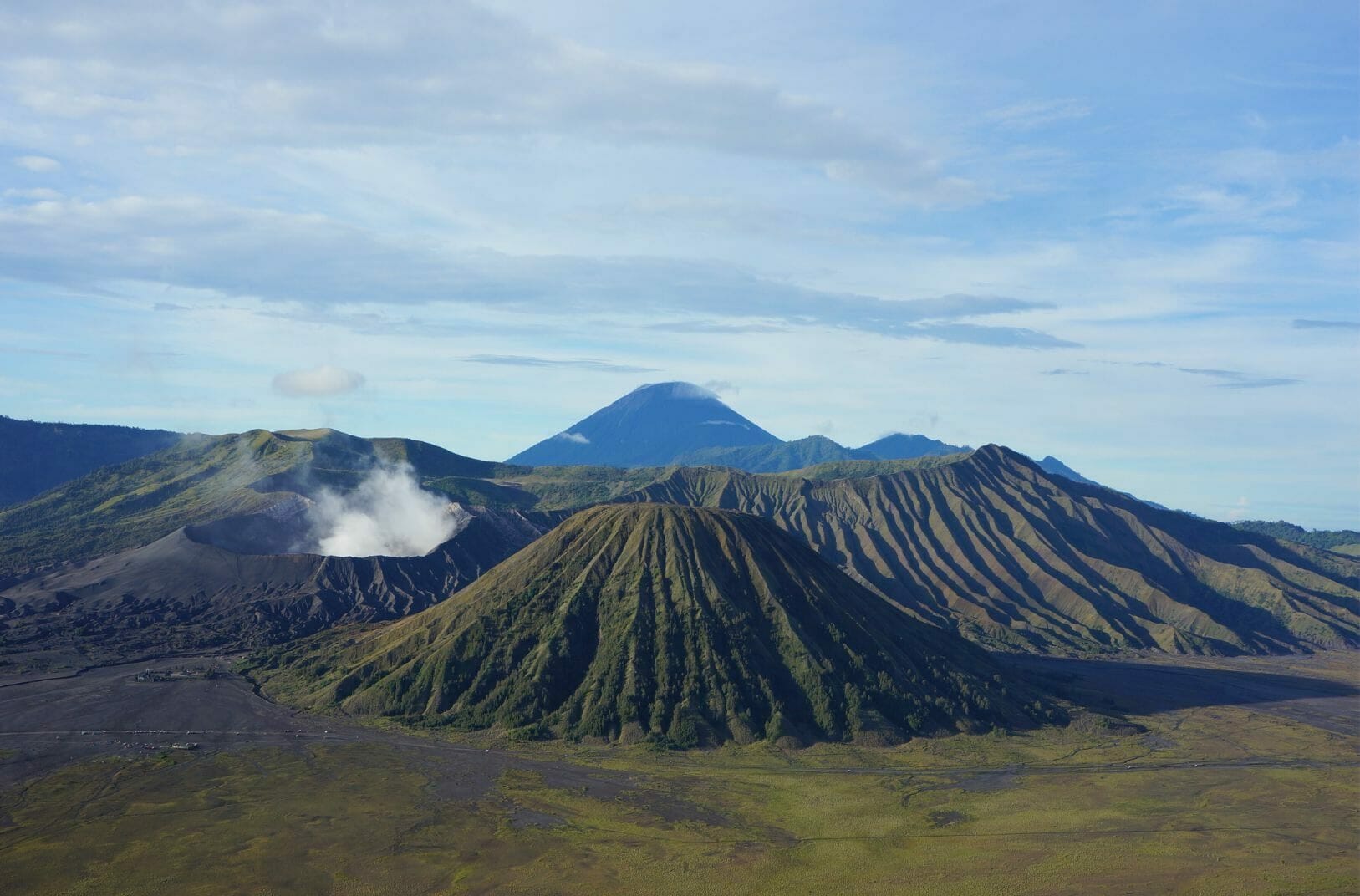

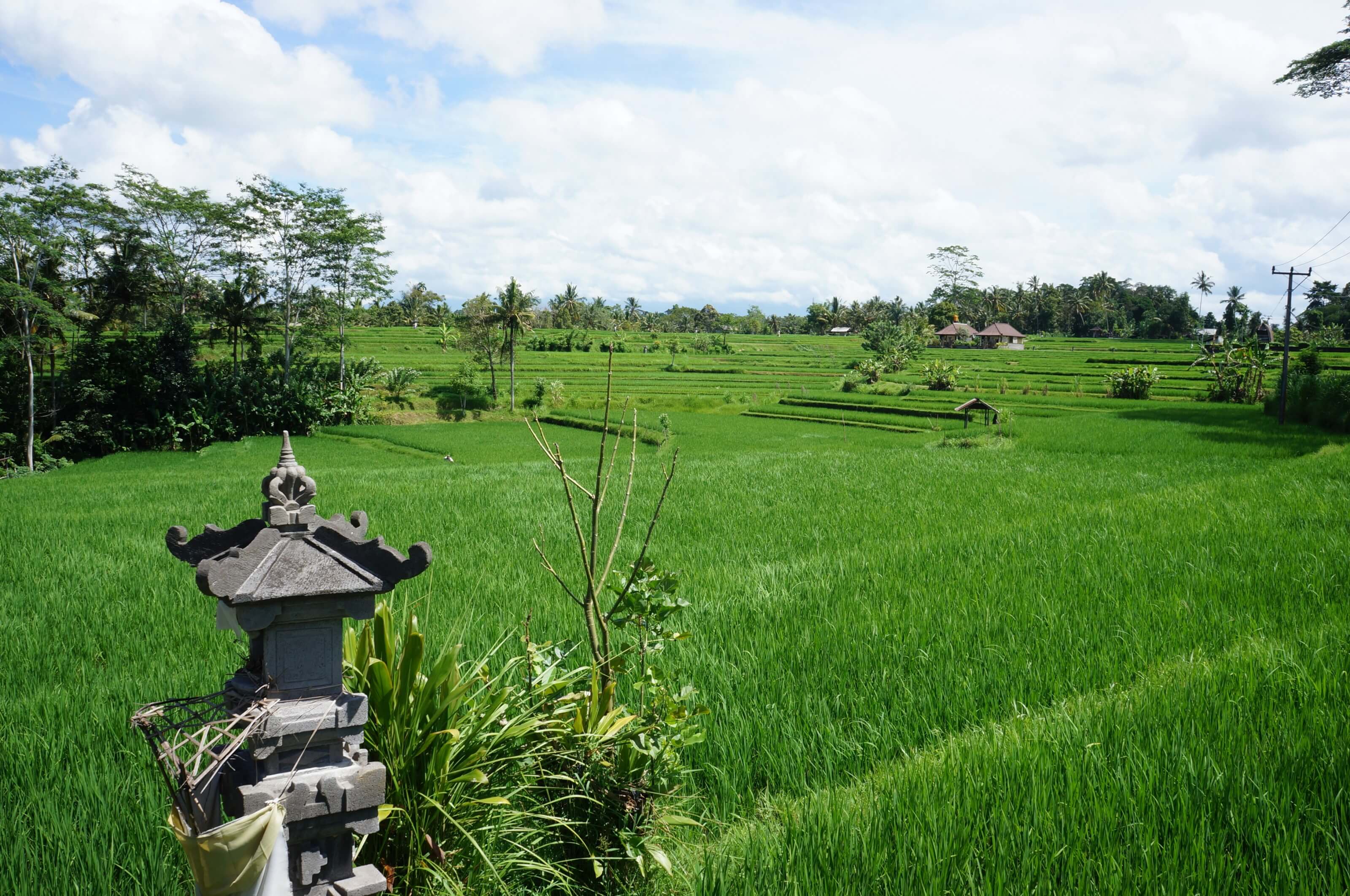
Hi Fabienne! I’m reading all your writings in your website because I’m looking for information about Turkey, then I saw your writing about Indonesia. I’m really happy to know that you visit Yogyakarta, and I’m really sorry to hear about your bad experiences. About the night bus, next time you visit here again, you should try the train instead of the bus. The night train will cost you about Rp 200.000- Rp 250.000 (economy class)/around $14-$18 as of 5 June 2021 and Rp 300.000 – Rp 500.000 (executive class)/ around $21 – $35 as of 5 June 2021. Also, our currency is Rp or Indonesia Rupiah, not Rupees (it’s Indian currency). Perhaps if you visit Yogyakarta again, you can catch me up through email. I live in Jakarta, but I often go to Yogyakarta, so I probably can provide you some information 🙂
I also want to thank you for providing me information about Turkey, it’s really useful for me. Hope both of you stay healthy and happy.